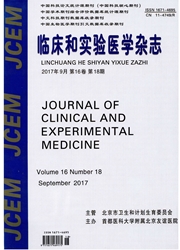

 中文摘要:
中文摘要:
目的:对大脑中动脉闭塞( MCAO)后存活患者进行长期随访,观察预后不良的影响因素,并进行分析。方法选取2006年1月至2013年12月住院就诊,行头颈部CT血管成像( CTA)或磁共振血管成像( MRA)证实存在MCAO的119例患者进行随访,以改良Rankin评分( mRS )为结局指标,将相关因素进行统计学分析。结果119例MCAO患者中失访17例(14.28%),平均随访46.8个月。将MCAO患者分为功能预后不良组( mRS〉2,48例)和功能预后良好组( mRS≤2,54例),并进行两组比较;功能预后不良组年龄、美国国立卫生研究院卒中量表( NIHSS)评分、超敏C反应蛋白( h-CRP)、纤维蛋白原( FBg)、D二聚体( D-Dimer)水平均显著高于功能预后良好组,甘油三酯( TG)水平显著低于结局良好组,差异具有统计学意义。Logistic回归分析显示年龄及NIHSS评分为结局不良的独立危险因素。结论年龄越大、NIHSS评分越高,MCAO后存活患者临床预后越差。
 英文摘要:
英文摘要:
Objective To observe and analyze the risk factors related to poor prognosis after middle cerebral artery occlusion( MCAO)by means of long-term follow-up of patients with MCAO. Methods One hundred nineteen cases of MCAO confirmed by the head and neck CT an-giography( CTA)or magnetic resonance angiography( MRA)in Beijing Friendship Hospital from January 2006 to December 2013 were followed-up. The modified Rankin Scale( mRS)was used to evaluate clinical outcomes,and the related factors were analyzed. Results Of the 119 cases, 17(14. 28%)were lost for the follow-up. The average follow-up time was 46. 8 months. Single factor analysis showed that age,the US Nation-al Institutes of Health Stroke Scale(NIHSS)score,h-CRP,FBg and D-Dimer levels in the poor prognosis group(mRS〉 2,48 cases)were significantly higher than those of good prognosis group(mRS≤2,54 cases),TG level was significantly lower than that of good prognosis group;and these differences were all statistically significant. Logistic regression analysis showed that age and NIHSS score were independent risk factors for the poor outcome. Conclusion The study indicates the higher age and NIHSS score relate to the poor prognosis of patients after MCAO.
 同期刊论文项目
同期刊论文项目
 同项目期刊论文
同项目期刊论文
 期刊信息
期刊信息
